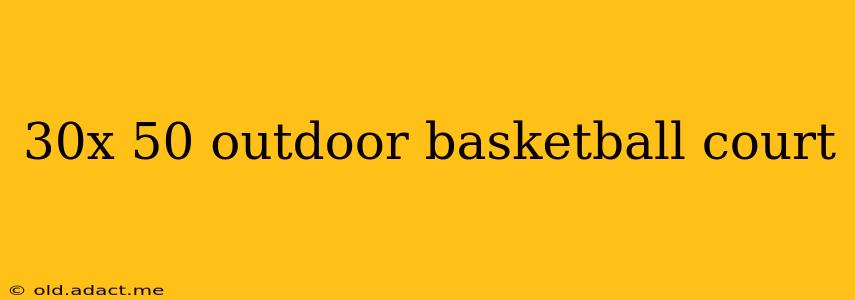Building an outdoor basketball court is a significant undertaking, but the reward of having your own private court is immeasurable. This guide will walk you through the key considerations for designing a 30x50 foot outdoor court, ensuring it meets your needs and exceeds your expectations. We'll cover everything from choosing the right surface to ensuring proper drainage and lighting.
What are the standard dimensions of a basketball court?
The standard dimensions for a regulation NBA basketball court are 94 feet long and 50 feet wide. A 30x50 foot court is significantly smaller, better suited for recreational play or a smaller space. While it won't be regulation size, it still offers ample room for enjoyable games. Keep in mind that the reduced size will impact the full-court experience, especially for fast-paced games.
How much space do I need around a 30x50 basketball court?
Beyond the 30x50 foot playing area, you'll need additional space for safety and maneuverability. Consider at least 10 feet of clearance on all sides (or more if space allows). This provides room for players to move freely, prevents balls from going out of bounds and hitting objects, and creates a safer environment. This means you'll need a total area of approximately 50x70 feet.
What is the best surface for a 30x50 outdoor basketball court?
The surface is a crucial decision impacting playability, maintenance, and cost. Here are some popular choices:
- Asphalt: A cost-effective and durable option, asphalt is readily available and relatively easy to install. However, it can become hot in direct sunlight and lacks the shock absorption of other surfaces.
- Concrete: Concrete offers superior durability and evenness compared to asphalt. However, it's more expensive and requires professional installation. Like asphalt, it can also get very hot.
- Poured-in-place rubber: This provides excellent shock absorption, making it gentler on joints and reducing the risk of injuries. It's also durable and weather-resistant, but it's one of the most expensive options.
- Sport Court: Pre-fabricated modular systems offer a variety of surface options with excellent shock absorption and drainage capabilities. It is often more expensive than asphalt or concrete.
What kind of drainage do I need for a 30x50 outdoor basketball court?
Proper drainage is essential to prevent waterlogging and maintain a playable surface. The best drainage systems incorporate a slope of at least 1-2% away from the center of the court towards the perimeter, allowing water to flow naturally. Consider installing perforated drain pipes beneath the surface for more efficient drainage, especially in areas with heavy rainfall.
How much does it cost to build a 30x50 outdoor basketball court?
The cost of building a 30x50 outdoor basketball court varies widely depending on the chosen surface, location, labor costs, and any additional features (like lighting or fencing). Expect to invest anywhere from a few thousand dollars for a basic asphalt court to tens of thousands for a high-end poured-in-place rubber or sport court installation.
Do I need a permit to build an outdoor basketball court?
Building permits are often required for construction projects of this size. Check with your local building department to determine the specific regulations and requirements in your area before beginning construction. Failing to obtain necessary permits could lead to fines or even demolition orders.
How much does it cost to maintain an outdoor basketball court?
Ongoing maintenance costs depend on the chosen surface. Asphalt and concrete require periodic sealing to prevent cracking and extend their lifespan. Other surfaces may need occasional cleaning or repairs. Budgeting for regular maintenance will help keep your court in top condition for years to come.
By carefully considering these aspects, you can design and build a 30x50 foot outdoor basketball court that perfectly suits your needs and provides years of enjoyment. Remember to always prioritize safety and adhere to local regulations throughout the entire process.
